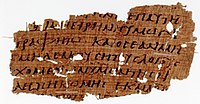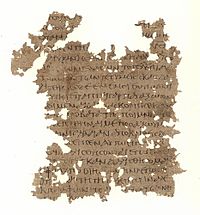Textual variants in the Gospel of Matthew
Textual variants in manuscripts arise when a copyist makes deliberate or inadvertent alterations to a text that is being reproduced.Origen, writing in the 3rd century, was one of the first who made remarks about differences between manuscripts of texts that were eventually collected as the New Testament.They may resort to performing a rearranging of words to retain the overall meaning without compromising the context."[2] Peter J. Gurry puts the number of non-spelling variants among New Testament manuscripts around 500,000, though he acknowledges his estimate is higher than all previous ones.[4] Note: This running list of textual variants is nonexhaustive, and is continually being updated in accordance with the modern critical publications of the Greek New Testament — United Bible Societies' Fifth Revised Edition (UBS5) published in 2014, Novum Testamentum Graece: Nestle-Aland 28th Revised Edition of the Greek New Testament (NA28) published in 2012, and Novum Testamentum Graecum: Editio Critica Maior (ECM) last published in 2017 — and supplemented by nonmodern publications wherever applicable, including those of Hodges & Farstad, Greeven, Lachmann, Legg, Merk, Nestle-Aland editions 25–27, Aland's Synopsis Quattuor Evangeliorum (SQE), Souter, Swanson, Tischendorf, Tregelles, von Soden, and Westcott & Hort.























Minuscule 447Minuscule 448Gospel of Matthewtextual criticismNew TestamentmanuscriptsOrigendittographyJohn MillPapyrus 1Papyrus 19Papyrus 21Papyrus 25Papyrus 35Papyrus 37Papyrus 44Papyrus 45Papyrus 53Papyrus 62Papyrus 64Papyrus 70Papyrus 71Papyrus 77Papyrus 86uncialminusculemanuscriptArabic versionsArmenian versionsByzantine text-typeCoptic versionsEthiopic versionsGeorgian versionsGothic versionsVetus LatinaVulgatepapyrusindividually numbered lectionarynumbered lectionariesSlavic versionsSyriac versionsLatin VulgateTextus ReceptusCodex SinaiticusCodex AlexandrinusCodex VaticanusCodex Ephraemi RescriptusCodex BezaeCodex ClaromontanusCodex CypriusCodex Mosquensis ICodex Regius (New Testament)Codex AngelicusCodex PorphyrianusCodex Vaticanus 354Codex Mosquensis IICodex WashingtonianusCodex DublinensisCodex Tischendorfianus IVCodex Sangallensis 48Codex KoridethiCodex ZacynthiusCodex Petropolitanus (New Testament)Codex BeratinusCodex Athous LavrensisCodex Athous DionysiouCodex Corbeiensis ICodex Corbeiensis IICodex Sangermanensis ICodex BobiensisEditio Octava Critica MaiorWestcott and HortNovum Testamentum Graece (Nestle–Aland)United Bible SocietiesEditio Critica Maior𝔐/ByzDidymusLectionary 54ℓ 76ℓ 211TheophilusIrenaeusChromatiusJeromeAugustineEusebiusEpiphaniusChrysostomAmbroseJustinHilaryHesychiusℓ 70ℓ 150ℓ 185ProclusPapyrus 101𝔓101CyprianJustin MartyrEphremGospelHebClementTertullianIgnatius𝑙76Liber GraduumAthanasiusAsteriusEphraemNestorius𝑙20Apostolic CanonsAphraatesGregoryTheodoretLuciferSpeculum𝔓64GospelNazPtolemyTheodoreCassianApostolic ConstitutionsTheodore of MopsuestiaCarpocrates